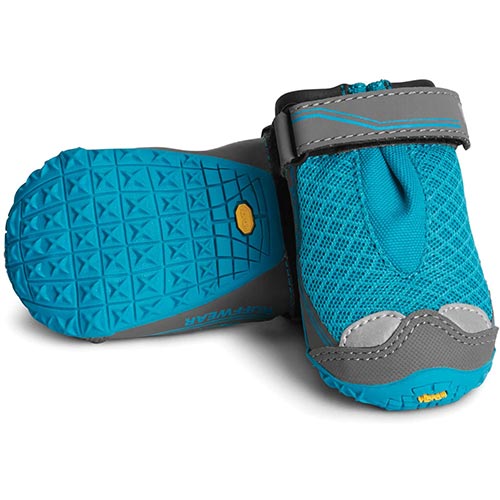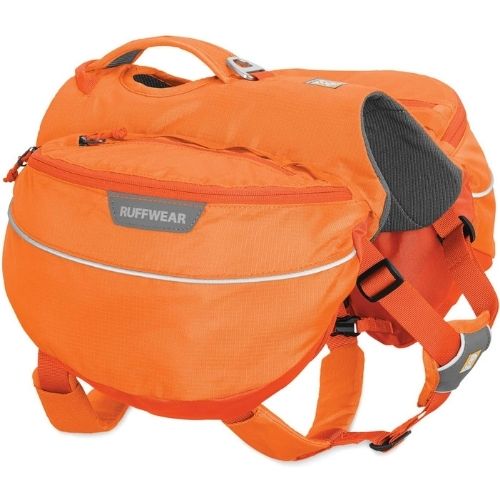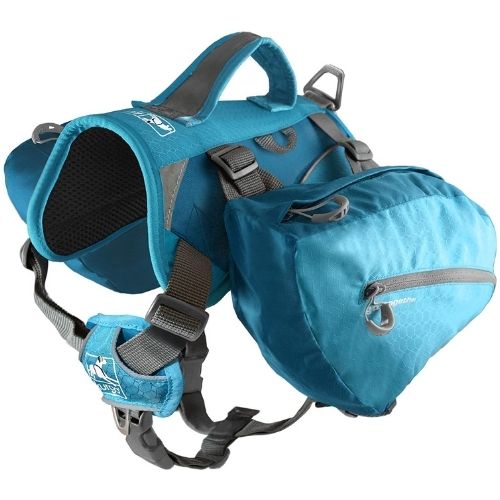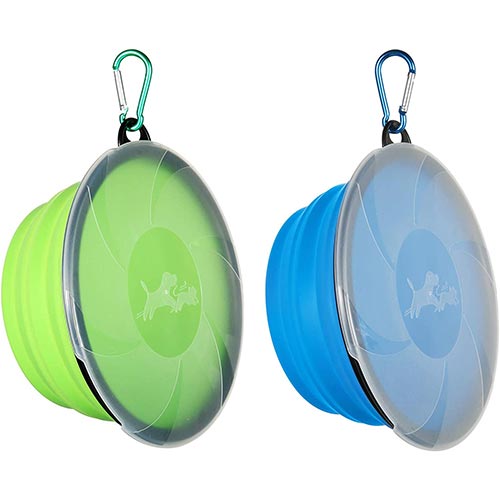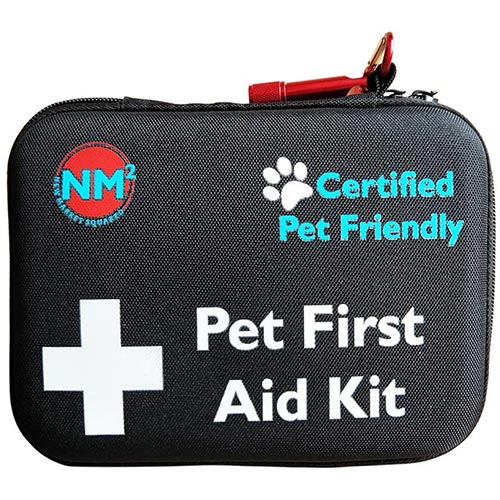
Hiking with your dog is a wonderful way to explore the great outdoors and reap the benefits of being outside and physically active.
Hiking the trails not only provides your dog with much-needed exercise but also gives their noses and brains a workout too.
Going on a hiking adventure together builds the bond you share with your dog and makes your relationship stronger. Before you take your dog on a hike or on a longer backpacking or camping trip, take these steps to ensure your pup’s safety while on the trail so you can reap the benefits of a fun trip together.
Plus, studies have shown that spending time outside surrounded by green space reduces human stress levels1 and has other medical benefits. It's good for both you and your dog!
Be sure to check out these trail safety tips from a veterinarian, who runs and hikes with her dogs, so you're prepared if your dog gets injured on a hike.
Should Your Dog Go on Hikes?
Prepare Your Dog for Hiking
Needed Vaccinations & Preventatives
What to Pack for Hikes with Dogs
Where to Hike with Your Dog
Should Your Dog Go on Hikes?
Should Your Puppy Go Hiking?
First, consider whether or not your dog is right for trail hiking. You don't want to take a puppy or adolescent dog on too strenuous of a hike until they've finished growing. Too much strain on a young dog’s growing bones can lead to pain and future issues with regular development. (Most of the "growth plates" in puppy bones close by about one year of age, but every dog and every bone can be different. Talk to your vet before starting any serious hiking or running program with your dog.)
Puppies also haven't built up their stamina yet — don't let their crazy play in the yard fool you — and will need some physical conditioning to get ready for the hiking adventure. Puppies also need some conditioning to get used to warmer weather, as they aren't as efficient as most adult dogs at regulating their own body temperature and are, therefore, at increased risk for heat exhaustion and heatstroke.
Should Your Senior Dog Go Hiking?
Older dogs can suffer from arthritis or painful joints that would make longer hikes more damaging than beneficial, but it's important to still keep them exercised and moving to keep them healthy. Older dogs have lower stamina and strength than a dog in the prime of their life.
You'll want to manage the difficulty of the trail and the duration of your hike and give your senior dog frequent rest and water breaks. Connect with your veterinarian to find joint supplements and an arthritis treatment plan that works best for your older (and wiser) pup.
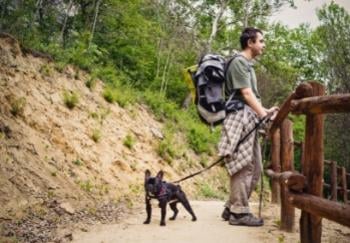 Should Flat-Faced Dogs Go Hiking?
Should Flat-Faced Dogs Go Hiking?
Brachycephalic breeds (short-nosed breeds like Pugs, French Bulldogs, Boxers, etc.) have shortened and narrowed nasal passageways, as well as other less-efficient aspects of their respiratory system, and are more prone to exhaustion and heat stroke during physical exertion.
Hiking might not be the best choice of exercise with these breeds, but you can mitigate the risk by going at a slower pace, providing frequent rest and water breaks, using a cooling vest, and only hiking during cooler weather. Consider bringing a dog backpack which you can use to carry them if they need a break from walking.
Also, if your dog's nostrils are particularly narrowed, talk to your vet (or a board-certified veterinary surgeon) about brachycephalic obstructive airway surgery — it can make a huge improvement in a dog's life!
Training & Behavior Considerations
There are a few training skills that your dog should practice before hitting the trails, which you can learn more about here. If you have a dog who exhibits reactive or aggressive behavior towards other people or dogs, hiking can be a good choice for physical exercise — as long as you choose trails that have low foot traffic and you are well prepared for management and safety when you do encounter others.
Leashed is always best while hiking so you can ensure your dog's safety, manage their behavior, and guide them away from precarious behavioral scenarios. Muzzle training should also be considered for dogs who may become aggressive toward others.
Prepare Your Dog for Hiking
.jpg?width=350&name=small%20husky%20mix%20dog%20sitting%20at%20trailhead%20on%20hike%20350%20canva%20(1).jpg) Build Up Your Dog's Stamina
Build Up Your Dog's Stamina
I don’t know about you, but I wouldn’t be able to go run a marathon today if you asked me to. And if I did go run a marathon without preparing, I’d definitely regret it tomorrow. I’d need to build up my endurance first (and learn to actually enjoy running).
Just like us, dogs need to build up muscle strength before strenuous activity to prevent soreness and injury.
Start with an easy hike, no more than one hour long with a small incline. Watch your dog's energy level during and afterward. If they seem really wiped out, shorten the next hike or choose an easier trail before incrementally adding more time and difficulty. Follow your dog's lead while on the trail — if they stop and lay down for a breather, let them rest and make sure they have plenty of water.
Plan for the Weather
Think about what the weather will be like when and where you're planning on hiking with your pup. Will you need cooling gear for hot weather, such as a cooling vest? Will your dog need some sunscreen to prevent sunburn?
If you plan on hiking in warmer weather, do so in the coolest parts of the day — morning hours and evening hours — rather than the middle of the day when it is the hottest. When the temperature is above 75 degrees, it's not recommended that you venture out on a long strenuous hike with your pup. The same goes for humid conditions! Dogs sweat by panting, which is much harder in hot humid conditions.
Or will it be cold and your dog needs some extra warmth from an insulated jacket (especially important for dogs with short or thin coats)? When hiking in snow or ice, cold-weather dog booties can prevent ice build-up between paw pads and toes and keep your dog's paws warm. As long as it doesn't get too cold for you to breathe, then it should be fine for your dog as well. But remember, ear tips, noses, and paws can get frostbite! So be aware when temperatures plummet.
In hot or cold weather, be sure to bring more than enough water for your dog while hiking. You can find out how much to bring in this article.
Get Your Dog's Paws Ready for Hiking
Your dog also needs to build up some toughness on their paw pads to prevent ripped or sore pads from a hike over different types of terrain. Dogs can also burn their paw pads on hot surfaces, so it's important to make sure they're protected. Check out our article How to Properly Care for Your Dog's Paw Pads for more in-depth information, tips, and our favorite dog boots.
If your dog has sensitive paw pads, or you want to make sure their paws are protected on hikes, grab some paw protection wax, like Musher's Secret, or invest in some dog booties!
These Ruffwear Grip Trex boots provide excellent traction for hiking, but if you plan on hiking in colder weather, these Polar Trex Booties offer insulation and winter traction. You can find more of our favorite dog boot picks here.
You don't want to just throw boots on your dog without some preparation, as many dogs can't figure out how to walk normally with them on without some practice. In this video, you'll see how to easily introduce your dog to wearing their boots:
Should Your Dog Wear a Backpack While Hiking?
It can be very useful to have your dog help carry their hiking supplies by having them wear a dog backpack. Not all dogs should wear a backpack, though — check with your veterinarian to make sure your dog can physically handle and has the right body type for the extra weight of a pack.
For example, my Corgi isn't a good candidate for wearing a backpack anymore because of her older age and long back, which puts her more at risk of a spinal injury.
If you plan on having your dog wear a backpack on your hike, you’ll want to get them used to wearing it and condition their body to build up needed muscles and balance.
The weight of your dog’s pack should never exceed more than 20–25% of their body weight — but don't start at that weight! Begin practicing with an empty pack and then gradually build up the weight over several sessions/days to best condition and gauge what your dog can handle. Also, check that the backpack is fit correctly, and supplies are balanced evenly for your dog’s body.
Choose a dog backpack based on your hiking needs — there are lots of options depending on whether you plan on backpacking, camping, or just going on a day hike. Ruffwear's Approach Dog Pack is form-fitting, and the placement of the saddlebags is great for helping your pup keep their balance.
Ruffwear also offers a great Core Cooler Chest Panel that can be clipped into any of their backpacks or harnesses — a great option if you're hiking in warmer weather. Another popular and quality dog backpack is the Kurgo Dog Pack.
Vaccinations and Parasite Preventatives
Your veterinarian will also make sure that your dog has any and all vaccinations they’ll need. Your dog might need additional vaccinations if you plan on hiking in certain areas, so be sure to mention it to them during your dog's wellness exam.
Ticks, fleas, and mosquitoes also pose a risk to your pup, as they can carry some nasty pathogens (such as heartworm, transmitted through mosquito bites, and Lyme disease from ticks). There are lots of options for parasite preventatives, ranging from chewables to topicals and even injectables. Your veterinarian can recommend which parasite preventatives will be best for your dog based on where you live, your hiking plans, and other pets in your home.
See this article for tips on what to do (and what NOT to do) to remove a tick from your dog.
Supplies to Pack When Hiking with Your Dog
No matter the length and difficulty of your hike, there are a few things you should always bring along for your dog:
- Water and Portable Water Bowl: Make sure you bring plenty of water for your dog to drink, along with a collapsible water bowl or water bottle, so they have a way to drink it. Plan for at least one quart of water for every three miles of hiking. Never allow your dog to drink from streams, rivers, or standing water which can transmit waterborne pathogens. If you plan on a long hike and cannot carry the required amount of water for your pup, bring along a portable water filter or water purifying tablets.
- Dog Food or Snacks: Dry dog food or treats are easiest to pack and carry while on a hike. Just like you might need to replenish your energy with a protein bar, your dog needs to as well. Stash a few treats or a bit of kibble in your backpack so they can refuel. These Energy Bars from Plato are easy to toss in your bag.
- Poop Bags: Remember — always pick up your dog’s poop and pack it out. Bring along plenty of poop bags and a larger plastic Ziploc or use a pack-out poop bag holder to store used bags until you can dispose of them properly.
- Dog First Aid Supplies: Pack a first aid kit, especially for your dog or add some dog-specific supplies. You can purchase a travel-size pet first aid kit, or you can make your own.
You want one that includes a pet first aid guide, saline solution, an antiseptic, antihistamines, gauze, heavy-duty stretchy bandages, antibiotic ointment, multi-tool with tweezers, tick removal tool (also useful for any ticks you find on yourself!), blood clotting powder, and cotton swabs.
- Extra leash: Bring an extra leash along in case your regular leash breaks, or you need to tether your dog with some extra leash length.
- Towel: Bring a dog towel along to dry your dog off if they get wet on your hike, and as a tool to cool down your dog if they are suffering from heatstroke.
- Dog Brush/Comb: Having a dog comb on hand is a great way to remove burrs and foxtails, and to help you check for any ticks on your dog throughout the hike and before returning home.
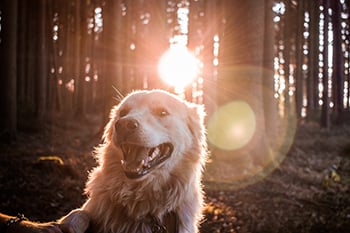 Where to Hike with Your Dog
Where to Hike with Your Dog
Double-check that the hiking trail you’re visiting allows dogs and see what rules apply. There are differences between where dogs are allowed in national, state, and local parks.
Look for signage at trailheads as well to ensure that dogs are allowed and whether leash laws apply.
Don't allow your dog off-leash unless you are hiking in a specifically designated off-leash dog area (Hint: These are rare). Off-leash dogs can startle or chase wildlife, other hikers, and other leashed dogs.
To find dog-friendly hiking trails, you can search online or invest in the Best Hikes with Dogs book based on your location or hiking destination. Alltrails.com offers trail guides and maps, and you can filter your search to include only dog-friendly trails. Try to avoid trails with rough or rocky terrain and other hazardous conditions, such as steep cliffs or drop-offs.
By planning ahead and helping your dog prepare physically for hiking, you and your dog will be able to fully enjoy your adventures on the trails.




